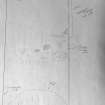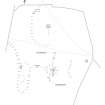Cairnholy 5
Cup And Ring Marked Stone (Neolithic) - (Bronze Age)
Site Name Cairnholy 5
Classification Cup And Ring Marked Stone (Neolithic) - (Bronze Age)
Alternative Name(s) Cairnholy 5; Cairn Holy; Kirkdale
Canmore ID 63728
Site Number NX55SW 30
NGR NX 51621 54804
Datum OSGB36 - NGR
Permalink http://canmore.org.uk/site/63728
- Council Dumfries And Galloway
- Parish Kirkmabreck
- Former Region Dumfries And Galloway
- Former District Wigtown
- Former County Kirkcudbrightshire
NX55SW 30 5161 5480.
NX 515 547. Cup-and-ring marks are carved on a smallish flat rock, easy to miss, 50yds N of NX55SW 29. The marks comprise 3 faint cups and one ring; rubbing shows 4 concentric rings in one case. In 1912 there were 3 cup marks, each surrounded by 3 or 4 rings, each figure measuring some 10" in diameter.
RCAHMS 1914, visited 1912; R W B Morris and D C Bailey 1967
Not located.
Visited by OS (RD) 29 February 1972
In a stony area 230.0m north-north-east of (NX55SW 29), 145.0m west of a field wall and 110.0m south of another wall is a smooth flat topped greywacke slab 1.5m by 0.5m. On its upper surface are the markings noted by RCAHMS.
Information from R W B Morris MS., January 1977
NX 5162 5480. The slab, as described, is very worn but the three cup marks are still traceable. Two of these cups each have a single ring but the four concentric rings could not be identified.
Surveyed at 1:2500.
Visited by OS (MJF) 7 July 1977
Van Hoek describes eight cups in all, two with a single ring, one with up to three rings and two with four rings each, the latter two being 350mm in diameter. Naddair identifies twenty cups, one with a single ring, one with two rings, two with four rings each, and a more complex figure consisting of two cups, having one and two rings, all enclosed within a double ring.
M A M Van Hoek 1995, K Naddair 1995.
Field Visit (28 April 1994)
The stone bearing these markings is in a pasture field 75m SSE of a ruined building (NX55SW 72). On its upper surface, which measures 1.6m NE-SW by 0.6m transversely, there are four cups, each with one ring, the largest having a diameter of 180mm. The largest cup measures 50mm in diameter and about 10mm in depth.
(Cree94 305)
Visited by RCAHMS (SDB) 28 April 1994
Note (10 September 2019)
Date Fieldwork Started: 10/09/2019
Compiled by: ScRAP Team
Location Notes: Located towards the upper end of a large field used for grazing, approximately 100m S of the N field wall (which runs E-W), 100m from the field gate in the dyke to the E, and Cairnholy 7 (ScRAP ID: 3235) which slightly lies to the E of this wall. This panel lies approximately half way between this field gate and one to the W at the opposite side of the field, just to the S of a track. Cairnholy 8 (ScRAP ID: 1090; Canmore ID: 77510) lies approximately 90m to the S, past a mound of stones (likely a large clearance cairn) c. 60m to the SSE. The ruined remains of Balmacrail (Canmore ID: 90249) lies c. 90m to the NW.
Panel Notes: The panel is a long, oblong shape running broadly N-S down the slope of the field. It measures 1.6 x 0.6m and rises to 0.3m at its heighest. Both ends of the panel are slightly raised above the level of the ground. The panel has a flat surface sloping slightly towards the SW with fissures crossing it at its S (lower) end. The main motifs are towards the centre and comprise a cup-and-four rings, the third of which is possibly only partial and the outermost of which is truncated by the edge of the panel. There is a further cup-and-two complete rings, with a third, partial ring, a large cup with a complete ring and a partial possible second ring, a cup with a possible partial ring, and a further possible individual cupmark. The surface is exposed to the air, and quite heavily eroded.


























































